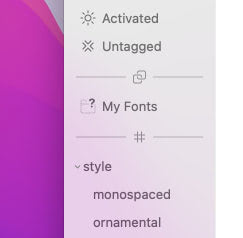Missing Fonts & Locations
If Typeface cannot access a certain font file or folder the app marks it as missing. Your fonts will be available again when access is restored.
Missing fonts
You tell Typeface where your fonts are stored by importing font folders (or individual font files). Typeface only has access to files located inside those folders.
When you move a font file outside of the folder(s) Typeface has access to, then the font will be missing. Depending on your app Settings the font will be removed from the app, or it will stay imported and show a question mark.
If > > > is enabled Typeface will automatically clean up fonts that are not accessible anymore. For example when you move a font file to the macOS Trash, Typeface will notice that and remove the font from your library.
The font file may have been removed accidentally — therefore the app will internally store a backup of the tags that were attached to the font. Whenever the font file is imported again into the app Typeface will restore its previously attached tags.
If is disabled Typeface will keep the missing fonts imported. Missing fonts will show a question mark instead of the activation indicator. Since access to the file is not available, you cannot activate or deactivate the font and it’s not possible to view font details.
When access to the file is restored the app will display it correctly again. It’s like nothing has ever happened.
You can manually remove a missing font from your library as follows:
- Right click (or control-click) on the font in Typeface
- Hold down the Option key
- Choose
Missing locations
If Typeface is not able to access an entire imported folder the item in the sidebar will show a question mark. This may be temporary if the folder is stored on an external disk which is disconnected. That’s why Typeface keeps the folder available in the sidebar and keeps all fonts (now marked missing) in the app. Fonts stay imported regardless of the setting.

When the connection to the folder is restored Typeface can display all fonts again. You can force Typeface to check if the folder is accessible:
- Right click (or control-click) on the imported folder in the sidebar
- Choose
Alternatively you can close and restart the app which will refresh all imported locations.
If the app is not able to restore access to the folder there are a few options:
1. The folder has been removed or should not be imported in Typeface anymore
You can manually remove the imported location by following these steps:
- Right click (or control-click) on the imported folder in the sidebar
- Choose and confirm
The location will be disconnected from the app and the fonts will not be visible in Typeface anymore. No files or folders will be removed from your Mac, but tags will removed from the previously imported fonts. If you plan to restore your tags later make sure to create a backup first before removing the location.
2. The folder is now located somewhere else the app has no access to
If an imported folder is renamed or moved Typeface can typically follow it around and keeps access to the new location. But if the folder is moved to a different disk, then the app will not have access to the new location. Moving files to a different drive is actually a copy to the new location followed by a removal of the old files. In this case Typeface does not automatically get access to the new (copied) location.
You can relink the imported location to the new folder:
- Right click (or control-click) on the imported folder in the sidebar
- Choose
- The app will notify you that the folder is not accessible
- Choose Relink Location
- Navigate to the exact same folder as the one you’ve previously imported
You’ll need to select the same folder, with the same files and subfolders, otherwise the app cannot find and relink to the correct font files.
Once relinked the app will have access to the fonts in the new location. All tags will remain available for the relinked fonts.
3. The folder is still stored in its original location, but is not accessible anymore
Typeface keeps access to a folder and its font files for as long as possible. If a folder has not been moved, but the app is not able to preview previously imported fonts there may be something wrong.
Please check if the folder is synced by cloud storage, such as iCloud or Dropbox. In order to preview fonts the files need to be available locally. It could be that the font files are stored in the cloud to make space on your Mac.
Navigate to your font folder in Finder and check if the font files show a small cloud icon. If they do then that means they’re not stored locally on your Mac so Typeface cannot show them.
To learn more on how to make the font files available locally please the Sync your font library article.
Are your fonts stored locally on your Mac in their original folder and the location is still missing in Typeface? You can try to restart your Mac which may resolve some macOS permission issues. Or choose > from the main menu to contact support.